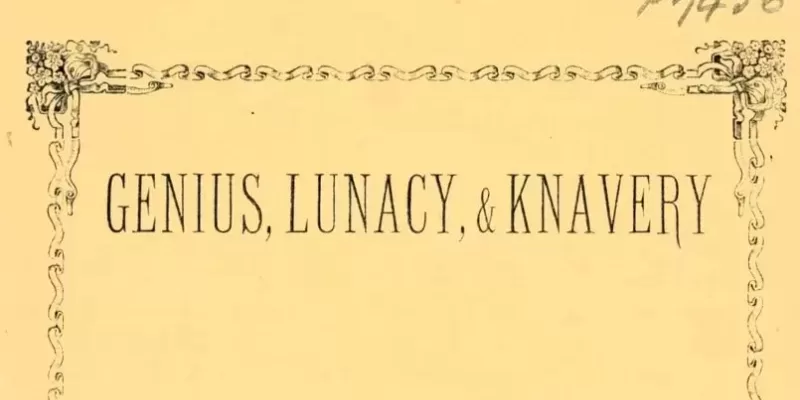From Australia’s Jewish Past:
Rabbi Dr David Hailperin
A Colourful Tale
First published in J-Wire October 25, 2022
Among the many colourful Jewish figures to appear in the annals of Australia’s early history, David Hailperin remains unique.
He was an ‘’old world’’ rabbinic scholar-turned-Kabbalist mystic and ‘’quack’’ physician. He lived in Australia for only five years, but in that short time, he managed to establish an enduring legacy.

The research comes from a short biographical book written by Maurice Brodzky in 1876, sixteen years after David’s death. Maurice was a Polish-born Hebrew school teacher, journalist, and historian who emigrated to Melbourne in 1871. The book titled “Genius, Lunacy and Knavery: A story of a Colonial Physician”, is unreliable to the point of doubtful authenticity, although widely circulated as being true, so David’s career remains, to some extent, shrouded in mystery.
While Maurice claims David was born in 1814 in the small Russian town of Revel, a British naturalization certificate states he was born in Bucharest in 1812. He was certainly a brilliant Torah scholar and an exceptionally gifted Yeshiva student, so much so that he was appointed rabbi of his township at a young age (according to Maurice Brodzky), with ambitions leading him further afield. He left his hometown, divorcing a young wife in the process, and traveled to Germany, Austria, and Jerusalem, where he studied Jewish mysticism and philosophy.
Throughout his life, David seemed to walk a thin line between respected Jewish scholar, community member, and crooked charlatan. It was around this time that he began to use the Kabbalistic arts to claim special powers, gaining a reputation as a ‘master of magic.’ He then turned his attention to medicine, claiming a degree from a dubious school in Istanbul. He was subsequently admitted as a physician to a number of institutions, including the Australian Medical Association. Whilst the institutions were all listed on his death certificate, his actual credentials could not be proven.
After a number of interesting events in Hamburg and London took place, including a mysterious warehouse fire and disputed insurance claim, David moved to England, where he apparently made an impression on the Chief Rabbi as a ‘great Hebrew scholar’ and man of faith, acting as a cantor and preacher for a private minyan. His dabbling in mysticism and magic continued, and he established
himself as a fortune-teller and solver of mysteries. In one particular case – using ‘magic’ – he helped recover stolen jewellery belonging to a certain butcher’s wife, who then left her husband and eventually followed David to Australia as his de facto wife.
He arrived in Sydney in 1855, and, at first, he enjoyed the reputation of being a highly scholarly man within the community. He even applied for the position of Chief Rabbi at Sydney’s York Street Synagogue, and though he provided impeccable references from respected members of the community, he did not get the job.
His next move was to Melbourne where he practised medicine and then traveled to the Bendigo goldfields. Around 1856, a rabbi from Poland claimed that David had the power to find ‘the mother lode’ of gold, whereby he performed a strange ritual requiring a tent stitched by a ‘’virgin’’, a young mother and various witchcraft that would supposedly reveal where the gold would be found. Alas, no gold was found. David is not explicitly identified as the rabbi in the story, but his track record would certainly indicate that he could be the likely culprit.
Interestingly, by the time this rabbi-doctor moved to the goldfields in early 1860, he had almost completely separated from his Orthodox Jewish past. He had no affiliation with any Jewish community or synagogue in the district.
A freak accident led to pneumonia and he died in July 1860. He was buried in a common grave at the White Hills Cemetery in Bendigo. It is presumed that he was buried in the Jewish section, but no Jewish minister is on record as having officiated at his funeral.
Why this mystical scholar, who, at times, had enjoyed the approval of the most respectable elements of Jewish society, ended up estranged from his community is unknown. Perhaps his charlatanism caught up with him, or even his marital situation of a de facto wife – who unfortunately tragically died from an overdose of laudanum (opium) within days of David’s death – may well have led to his being ostracised. Whilst there is this strange murky story about this rabbi-doctor, there is one redeeming feature – a legacy that is still existing today – in that there is a stunning collection of Jewish and Hebrew literature which is now housed in the Rare Books Department of the Melbourne Public Library. Not exactly to his credit, as during his time in Melbourne, he pawned this collection, comprising about 160 volumes, for ten pounds in order to finance a chemist shop. The books somehow ended up in the hands of Reverend Isaac Pulver, who sold them to the library in 1864. It is amazing to think that he brought these books across the seas and, indicating a testament to his Jewish faith.
It appears that some of these books have been the subject of international studies. In fact, one – Sefer Migdanim – was discovered by the Hebrew University National Library to be the only copy in existence. Scholars had known of the work through references by other medieval authorities, but not until his book was discovered in the Melbourne Public Library was the original work actually traced.
Acknowledgments
- Genius, Lunacy and Knavery: A story of a Colonial Physician” by Maurice Brodzky;
- Mirage News – Monash project;
- Australian Dictionary of Biography

